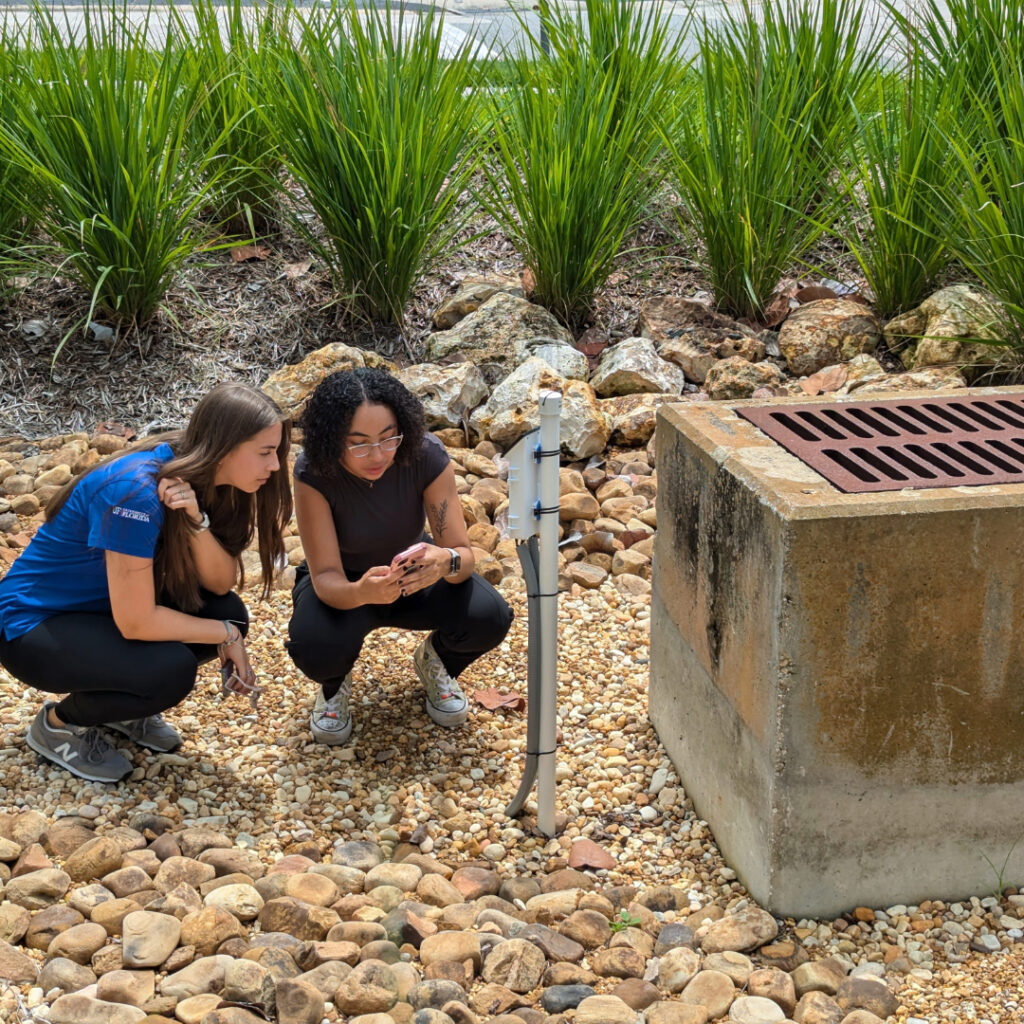Stetson student Phoenix Medley teaching me how to read the water level gauge at the bioswale. Picture by Sofia Cordoba .
With concerns from citizens, researchers, and the city, the beginning of a joint effort between Stetson University’s Institute for Water and Environmental Resilience (IWER), City of Cape Canaveral, FL, the East Central Florida Regional Planning Council (ECFRPC), Embry-Riddle Aeronautical University (ERAU), and the Florida Sea Grant (FSG) was created. A three- part community charrette- a meeting where stakeholders in a project attempt to resolve conflicts and map out solutions- was conducted in Cape Canaveral to assess the stormwater challenges in the area and the development process for a local GSI to be implemented.
Many factors come into play when deciding what form of GSI would be most adequate to use which include local soil characteristics, such as how water moves through different soil types, the natural history of the site, the variability in soil profiles, and the specific conditions of the area, like land surface and rainfall patterns. It emphasizes the importance of site-specific data and understanding both past and present conditions to design effective and sustainable GSI solutions. After looking at some of these factors, the city decided the best approach was the formation of a bioswale.
Engaging Community through Citizen Science
The bioswale in Cape Canaveral also has another portion to it: the native plant rain garden. The nutrients that are absorbed from the storm waters act as food for the plant. The rain garden creates an attractive appeal to the bioswale with its vibrant flowers and varying green colors, including Canna Lily, Coonite, Sand Cordgrass, and Fakahatchee grass can be seen throughout the park beautifying the city along with it.
Canna Lily flowers located in the bioswale/rain garden. Picture by Sofia Cordoba.
Dr. Jason Evans, the principal investigator for the project and executive director for IWER, states “I think that it’s important, especially within some of the urban core, that we use the opportunity to beautify and make it to where your green infrastructure becomes this community amenity”. It not only attracts the public to the bioswale but also wildlife.
The native plants of the bioswale aim to attract native pollinators to the garden to help increase the ecological process of pollination and biodiversity within the area. Florida Sea Grant extension agent with the UF/IFAS office in Brevard County, Holly Abeels, was in charge of bringing a pollinator monitoring survey to the bioswale. She explained the reason behind including the pollinator survey was another way to engage more community members by monitoring native bees and butterflies that make their way to the rain garden.
The data being collected will also show how bioswales are beneficial to communities in more ways than one. “Education is key to any community engagement,” says Abeels. “The thought behind the monitoring is to show the benefits of this type of garden. Collecting some of that monitoring data can serve as a point of information for cities that might want to put rain gardens in”.
Forward Thinking for a Greener Future
Pollinator monitoring is not the only data being collected from the bioswale, Stetson’s IWER team also are collecting data to be able to calculate the rate at which water on the ground surface enters the soil, and whether or not it is fulfilling its purpose of acting as a filter. Throughout the bioswale, there are different sensors attached to wells that measure soil moisture or water gauge levels. Andrew Joesoef, lab manager for Stetsons IWER, explained that there are 6 soil moisture sensors at each well at different depths ranging from the surface to the water data, and are able to measure the ratio of water content per cubic inch of soil.
Figure 1.
“Eventually, I think we can use this data to calculate infiltration rates” says Joesoef. “Knowing these rates can then help determine whether the bioswale is doing its job.” These sensors are able to capture what it is the water that enters the bioswale is doing and how the bioswale is processing that water
In Figure1 (pictured left), you can see changes in the water table over time. The dates shown on the graph are 5/30/24-6/13/24 indicating a rainfall event. The up and down pattern possibly is associated with transpiration- when plants release excess water, similar to sweating- from the large oak trees located next to the bioswale.
Capturing the bioswales magnitude. Picture by Sofia Cordoba
“During daylight, the trees are photosynthesizing and their roots are drawing in water from the water table and transpiring it, causing the level to go down. At night, when transpiration stops, the water table then recovers a bit.” states Dr. Evans.
None of this would have been possible without the collective efforts of everyone involved in the project, including researchers, stakeholders, city council members, and citizens. The National Science Foundation Civic Innovation grant awarded $1 million to this project, enabling its realization. Speaking on the collaborative efforts Eichholz states “It shows that working together through these challenges is the only way forward, as no city, especially smaller ones, can address these issues alone, nor should they”.
This project in Cape Canaveral serves as a model for other communities, demonstrating how collective action can address common issues, such as the stormwater flooding many Florida cities face. GSIs have valuable benefits to help mitigate these preeminent concerns that at a larger scale could make waves of positive impact to communities and to the environmental challenges we currently face throughout many coastal areas in the United States. “We need to implement more projects like this on various scales,” says Dr. Evans. “Addressing stormwater issues requires continued efforts like these.”
